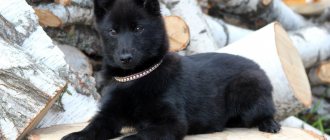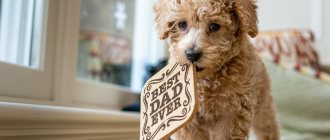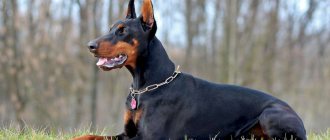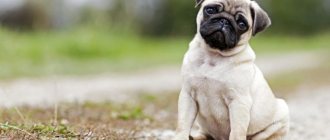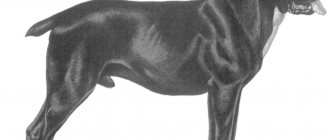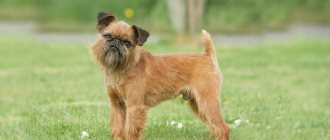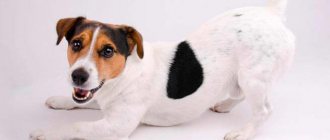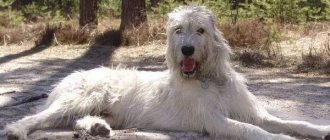Many people dream of having a shepherd, but cannot get one due to the large size of this dog. Such people would be well suited for a Schipperke - a rare breed of dog of compact size and decorative appearance, possessing the qualities and seriousness of a service dog. But don’t let its small size fool you, this dog needs a firm hand, because it’s not for nothing that it’s called the “black little devil.”
- 2 Description of the breed
2.1 Table: features of the appearance of the Belgian Schipper - 2.2 Schipperke character
- 2.3 Table: breed disadvantages and disqualifying characteristics
- 2.4 Video: main features of the Schipperke breed
- 4.1 Schipperke nutrition
History of the breed
The homeland of dogs is in Belgium, where they served as hunting dogs and were used to kill rodents. In addition, black dogs coped well with protecting the stingray and the owner’s property. Schipperke was first described in the 19th century.
This breed has a very interesting history. In the 14th century, a law was passed in Belgium that allowed only aristocrats to keep large dogs, but such a luxury was not permissible for ordinary people. The way out of this situation was to breed two types of shepherd dogs - large and small.
From Belgian territory, this law spread to other European countries. Accordingly, Schipperke began to gain popularity. Their recognition dates back to 1882; around the same time period, the breed was officially described and a standard was published.
Black dogs became very popular in England; the puppies brought to Foggy Albion made an indelible impression on the members of the royal dynasty, which is what made the Belgians very fashionable. The nobility did not pay much attention to the purebred of the dogs; for the aristocrats, only the black color, the lack of a tail in the puppy, and Belgian “citizenship” were important.
Description of the breed, characteristics
Purebred dogs have a harmonious physique and thick coat. The body is tightly built with well-developed muscles. Despite the lightweight bones of the skeleton, the joints are well positioned. The muzzle is shortened and this feature makes Schipperkes have an attractive appearance. Males and females have differences in size and proportions.
Modern Belgians are considered companions, ideal for family life; in addition, dogs can serve as protectors. Representatives of this breed are cheerful, energetic and curious animals. They are constantly moving, interested in the world around them and enjoy exploring previously unknown places.
Such fidgets need frequent and long walks so that they can throw out excess energy. Otherwise, the Schipperke will begin to show increased activity, which consists of constantly spinning underfoot and getting attached to the pets. Belgians take great pleasure in traveling, and they really enjoy traveling by car, when the dog can admire the surrounding landscape through the window.
Representatives of this breed are able to spend a lot of time in outdoor games, and therefore Schipperkes are often found in families with children. True, adults will have to forget for a long time what peace and quiet is due to the noisy company.
Worth knowing. Belgian dogs are not the best option for those with very young children. Careless handling makes the pet extremely irritable.
Despite their small size, the dogs are very brave, fearless and strong. If the need arises, the animal will enter into a fight with an opponent of large size. It all comes down to education; if a dog is not trained correctly, it becomes a real problem. Schipperkes can become aggressive even to their owners.
Belgians are famous for their vigilance; they do not miss a single extraneous sound, and notify about them with a loud bark. This behavioral feature causes trouble for both the owner and others, which means it needs to be corrected. Trained dogs quickly fall silent as soon as they are given a specific command.
Socialization
Early socialization of the Schipperke is necessary to develop an adequate perception of other animals and people. After the routine vaccination, the puppy is taken out into the world - to the puppy pad. There he gains experience in communicating with his peers, which allows him not to be afraid of his four-legged brothers in the future.
If there are small children in the family, the Schipperke puppy will become their faithful friend in games and mischief. The younger generation should not be left unattended. A child who does not measure his strength may accidentally hurt the dog, for which the dog may snap back or bite lightly in response.
If there are small pets in the house, such as hamsters, guinea pigs, birds, the dog may perceive them as potential prey. It is better to hide such pets away from the Belgian. But with cats and dogs, quite friendly relationships can develop, especially if everyone is about the same age and grows up together.
Breed standard
Each breed has certain requirements regarding appearance, and the Schipperke is no exception. You can see the approved measurements in the table below.
Breed standard
| Parameter name | Description |
| Head | It has the shape of a shortened wedge. The muzzle is neat, tapering towards the nose. The frontal lobe is wide, the lips are dense. The eyes are almond-shaped and have brown irises. |
| Teeth | Dogs have a regular straight bite. Individuals with an incomplete set of teeth are not non-standard, so a Schipperke may lack a third molar and second premolars |
| Ears | Small in size, vertical, flexible, with a pointed tip |
| Torso | Has the shape of a square. The cervical region is of medium length, quite wide. The chest is tightly built and dropped down. The dorsal region is wide, short, the withers are well developed, the back flows into the lower back, the croup is rounded |
| Paws | Powerful, hind limbs longer than forelimbs |
| Tail | There are tailless individuals (deprived of it from birth), and it can also be docked briefly or left in the form in which it is. The tail may curl strongly, this is not a flaw |
Appearance
Schipperke (schipperke) is a small shepherd dog with a harmonious, strong, square build. She has a very expressive face, pointed ears and short black fur. In general, the Schipperke's appearance should reflect strength, endurance and willingness to work. Average weight 4-7 kg.
The Fédération Cynologique Internationale (FCI) standard allows only black color in the breed. In England, golden Schipperkes are also allowed, and in America - gold, chocolate, blue and black and tan. There are some differences in appearance too. Thus, American type dogs are heavier, with thicker, richer hair and an expressive head, while European type dogs are more graceful and light.
The head is not too long and rather wide, wedge-shaped. The stop is noticeable. The forehead is wide, the upper lines of the muzzle and skull are parallel. The muzzle tapers towards the nose, its length being approximately 40% of the length of the head. The bridge of the nose is straight. The lobe is small, black. The lips are close-fitting and black. The teeth are healthy, firmly set, scissor bite, straight is allowed. The eyes are dark brown, almond-shaped, small. Eyelids black. The look is lively and mischievous. The ears are small, pointed, erect, triangular in shape, set high, very mobile.
The neck is strong, strong, because of the collar it seems very voluminous, it is carried high, the upper line of the neck is slightly curved. The body is wide and short. The topline is straight, often slightly raised from the croup to the withers. The withers are well expressed. The back is straight and short. The loin is wide. The croup is horizontal, smoothly rounded, which is why it is compared to the croup of a guinea pig. The chest is wide with rounded ribs and descends to the elbows. The hemline is slightly tucked. The tail is set high. Bobtail is normal for the breed.
Some dogs are born with short tails. At rest, the tail is naturally long, reaching to the hocks, hanging down, slightly curving at the end. When moving, it can rise to the level of the back. A curled tail or thrown over the back is also acceptable.
The limbs with very good bones are placed under the body. The front are straight, parallel, their length from the ground to the elbows is approximately half the height at the withers. The hindquarters, when viewed from behind, are parallel with long, muscular thighs. The hock joints are well defined. Dewclaws are undesirable. The paws are round, small, the toes are well assembled with very strong, black short claws.
Double wool. The guard hair is abundant, thick, rather coarse, straight, strong in texture, durable and dry to the touch. The undercoat is soft and dense. The hair on the ears, head, front of the legs, hocks and metatarsals is noticeably shorter. On a body of medium length, fits tightly. It is slightly longer on the neck, forming a collar, and “pants” on the back of the hips. The hair on the tail is the same length as on the body. The color is exclusively black. With age, a little gray appears on the face.
Advantages and disadvantages of Schipperke
The most positive quality of representatives of this breed is very good health and unpretentiousness to living conditions. Belgians do not need comfort; keeping them in an enclosure is also suitable, where the dogs will not freeze because they have a thick undercoat.
Quick learning is another positive feature of shepherd dogs, which also includes being owner-oriented. Dogs are working dogs, and therefore the owner will need to realize the natural qualities of the pets; if this condition is met, then the Schipperke will make an excellent companion.
If we talk about the disadvantages, many cite a very high price that will have to be paid for a representative of this breed. Another disadvantage is the need for the owner to spend a lot of time with his pet when it is undergoing psychological stabilization. This period occurs between 21 and 105 days of age.
Pet Games
The cause of all the problems that may arise when keeping a Schipperke is boredom. Mini Shepherds are incredibly energetic animals that vitally need the release of accumulated energy. Not knowing what to do with himself, the Schipperke becomes an empty-headed dog: he will bark, reacting to every rustle. In this way he spends his strength, guarding and protecting his family.
The dog, not being able to release its accumulated energy, will actively chase the cat, pester guests, and during a walk look for a potential enemy in order to start a fight. Therefore, it is important to think about what to do with your pet.
Thanks to his small stature and inexhaustible energy, the choice of games is incredibly huge. Schipperke will be very happy to accompany the owner in sports games such as frisbee, obedience, agility, freestyle or fetch.
Interesting! Schipperkes can be used for hunting small game, acting as a gun breed or for carrying prey. In addition, dogs swim well and enjoy it, and also follow the scent.
Maintenance and care
The potential owner of a Belgian should remember that the coat of black dogs requires constant care. Schipperkes shed three times a year for 10 days. Despite the fact that the time period is not that long, the owner will have to comb his pet every day. Grooming and trimming are not used for dogs of this breed.
Good to know. Shepherd dogs from Belgium are rarely bathed. Dogs love snow very much, and therefore clean their coats themselves using snowdrifts for this purpose. On a hot summer day, your four-legged pet will not without pleasure climb into a pond to swim. Dogs are bathed purposefully if there is an emergency need for this.
Belgians' teeth are quite strong, and therefore the oral cavity is examined once a month to prevent the formation of plaque. Ears and eyes need more attention. If lacrimation occurs (a rather rare occurrence), a special ophthalmic rinsing solution is used. Ears should be cleaned once a week.
Mandatory care for the Schipperke also includes keeping the dog in good physical shape. This will require long walks and a balanced diet. Belgians do not complain about their appetite, and can eat anything edible that comes their way.
Nurseries
Five reasons to buy a puppy from a kennel:
- Support and assistance on care and education issues.
- All individuals of the breed are examined before mating.
- Puppies are tested for carriers of genetic diseases.
- Puppies undergo socialization, receive the necessary vaccinations according to their age, and eat high-quality food.
- Guarantee of breed purity, availability of documents.
Nursery addresses:
- Moscow region, Pushkino, nursery "Muranovo" https://muranovodog.ru/
- Moscow region, Krasnogorsk, nursery “S Krasnaya Gorka” https://krasnogorka.ru/contact.shtml
For a person choosing a pet, the smallest shepherd dog will be an excellent companion for walking together. A perky and playful dog, at the same time promptly responding to the commands and mood of the owner, not demanding in care and maintenance - there are a lot of advantages in a small dog with a huge loving heart.
Feeding
For representatives of this breed, feeding with both factory-made feed and natural products is suitable. In the latter case, you need to remember that the food must be balanced. This point is important not only for puppies, but also for adult dogs.
When choosing among brands of dry food, preference should be given to super-premium or premium class designed for dogs leading an active lifestyle and belonging to medium breeds. As for the amount of food per day, manufacturers calculated it long ago and put it in a table, which should be on the back of the package.
If natural feeding is used, the dog must receive the following products:
- beef;
- cereals;
- fermented milk products;
- vegetable and fruit crops.
Meat should account for at least 1/3 of the total diet. It is recommended to give vegetables and fruits to animals fed both natural and factory feed.
Character
An unpretentious and non-conflicting animal - this is how you can describe the character of the little Belgian in a nutshell. The historical purpose is to protect and protect the house from rodent infestation. Guard instincts are strong to this day.
Being close to the owner, a dog of the Schipperke breed is ready to rush to the rescue at the slightest danger, completely not comparing its small stature with the magnitude of the threat. Protecting their territory is a favorite pastime of the Schipperke. It is impossible to pass by him unnoticed. Whether it’s a private house and its surrounding area, or a small apartment in a high-rise building, a ringing bark will warn the household that guests are approaching.
A curious and cunning Schipperke dog is suitable for people leading an active lifestyle. Will be happy to accompany you on long walks or car rides.
Upbringing
Belgian dogs require consistent training, which should begin from puppyhood. Schipperkes are distinguished by the fact that they quickly lose interest in training. If, over the course of several days, they are forced to learn the same command, the dog will very quickly stop following it.
The essence of education is to force the animal to perform the functions that are inherent in it by nature. The main aspect here is weaning off incessant barking, which is quite a difficult task. The Belgian should bark to notify about the visit of a stranger, but not react in this way to the arrival of guests already familiar to him.
When a puppy arrives at a new place of residence, it is necessary to begin the educational process with him. He needs to be taught to do his business in a diaper until the end of quarantine after vaccinations. Then the dog is taught to relieve itself while walking. Belgian Shepherds have a certain thirst for knowledge, but the main characteristic here is the ability to please the owner. During classes, a trusting relationship must be established between the owner and the pet.
According to the observations of dog handlers, the best training for representatives of this breed are courses such as:
- agility;
- flyball;
- international obedience course.
It is recommended that the dog undergo OCD, which begins at the age of six or eight months. Before starting training with a professional instructor, the owner will have to teach the pet the most common commands. Schipperkes are a late-developing breed and can be considered adults from the age of 3 to 4 years.
Attitude towards strangers
Suspicious and wary by nature, Schipperkes are extremely vigilant. These amazing dogs consider themselves great watchdogs, they simply believe it. Fearlessness and devotion are hidden behind the deceptive appearance of small animals. Pets strive to be useful to their owner, so they will definitely warn about the approach of strangers. The Schipperke will immediately warn about strangers who have aroused suspicion or disrupted order from the dog’s point of view with a piercing and sharp bark.
Reserved by nature, the breed requires early socialization in order to respond adequately to the environment and people. Otherwise, the dog will often bark and even rush at strangers, trying to bite them.
If a stranger often appears in the house where the animal lives, then as a result of slow rapprochement, frequent communication can lead to the Schipperke and the stranger becoming good friends.
Parenting mistakes
The most common shortcoming in Schipperke training is considered to be late socialization. Such dogs fully demonstrate their stubborn character and can begin to show aggression towards the owner and members of his family. An ill-mannered Belgian often raises his voice at a time when there is no need for it. Constant barking bothers not only the owners, but also the neighbors, which leads to conflict situations.
Puppies
As for purebred dogs, both parents must have properly executed documents, and the pet itself must have:
- puppy card;
- veterinary passport, which indicates the vaccinations already done;
- brand.
When choosing a puppy, you need to see how it behaves. Some representatives rush from one extreme to another, which sooner or later will become the source of many problems. You should choose the “golden mean”:
- playfulness;
- activity;
- curiosity;
- moderate aggressiveness towards others.
Choosing a puppy
When choosing a pet, you need to pay attention to the following aspects:
- health. The puppy must have average fatness, eyes, ears and genitals must be clean. The coat is shiny, there is no dandruff or bald patches. The dog should move confidently without lameness;
- the body must meet the breed standard, because the skeleton will not change its proportions with age;
- representatives of the breed can appear with or without tails; some individuals are born with defective “stumps”. All this is absolutely normal and does not apply to marriage. Tailed Belgians should have no creases (they can be seen in puppies one month old);
- coat The color of the undercoat is similar to the color of the heels. For fair-skinned dogs it will be grey, for dark-skinned dogs it will be black.
HEALTH
The average life expectancy of “black devils” is approximately 12-15 years, but Schipperkes are susceptible to genetic diseases.
In addition to dysplasia, which most often appears in Schipperkes in adulthood, dogs can suffer from hypothyroidism and rare mucopolysaccharidosis (occurs in 15% of dogs of this breed). The dog's thyroid gland is usually treated with medications; for mucopolysaccharidosis, individual treatment is selected, since the consequences of this disease are much more serious than the disease itself.
Elderly Schipperkes often suffer from cataracts. At any age, a dog can also experience retinal atrophy, which is often an independent disease or a consequence of eye injury. In rare cases, Schipperkes may suffer from epilepsy.
Breed diseases
Schipperkes have quite good health, but they can also develop diseases, especially of hereditary origin. The following pathologies are often diagnosed in dogs:
- epilepsy;
- diseases of the visual organs - cataracts, retinal atrophy;
- hypothyroidism – occurs when there is a deficiency of thyroid hormones;
- hip dysplasia;
- Perthes syndrome;
- mucopolysaccharidosis.
Subject to regular preventive examinations, proper care, and timely vaccinations, the pet will live at least 13-15 years.
Price
Belgian dogs are quite expensive:
- pet class - animals that do not go to exhibitions or for breeding - 30,000 rubles;
- breeding class - dogs with a good pedigree and approved for mating - 40,000 - 60,000 rubles;
- show class - a puppy with titled parents, suitable for participation in exhibition events, will cost the potential owner 70,000 rubles or more.
Interesting Facts
Over the long history of the breed’s existence, many interesting things have been associated with the Schipperke:
- Translated from Flemish, schipperke means “shepherd boy” or “little boatman”. And from the ancient Brabant dialect - “little shepherd dog”.
- At one time, Schipperkes were popular among workers and shoemakers in the Belgian quarter of Saint-Gery. They competed with each other, decorating their pets with intricate copper collars.
- Among the Schipperkes there are individuals with golden, cream, chocolate and black and tan coats. But such dogs are considered not to meet the standard and do not take part in exhibitions.
Names for boys and girls
When choosing a name for your pet, you should remember that it will be pronounced very often. Therefore, the nickname should be sonorous and not too long. There are several options for choosing a name for a Schipperke:
- you can look at the list of names suitable for a given breed and choose the one that you like most;
- choose an unusual nickname based on other sources, for example, myths, literary works, give the name of any famous person, or come up with something of your own.
The most common names for female dogs are:
- Mary;
- Nymph;
- Rabi;
- Carla;
- Aglaya;
- Ellis.
The male can be called:
- Sherry;
- Brady;
- Carbon;
- Bamsi;
- Dzhigit;
- Brandy.
Buying "from hand"
The advantage of this method of purchasing an animal is that it costs relatively little. At the market there are resellers called “breeders”; some sellers bring dogs whose breed and health they know nothing about. Although the price tags are lower than in dog breeding organizations, there is a risk of loss in purchasing a non-purebred or sick animal, which can be adopted for free.
To avoid becoming a victim of deception, you need to have a good understanding of the exterior of purebred animals and be able to visually recognize signs of disease. Try to find out the seller's address so you can contact him if any misunderstandings arise.
Owner reviews
Albina
I always wanted to have a service dog, but a small apartment is not the best place for a large dog, so I chose a Schipperke, who turned out to be an excellent companion. The shepherd dog, originally from Belgium, is remarkably trainable and becomes a true friend for its owner.
Egor
Our four-legged pet is very affectionate, but only shows his friendliness to members of our family. Strangers arouse suspicion and wariness in him, which makes the Schipperke a good watchman and security guard. I think that this breed has some disadvantages: the dog’s desire to participate in all the activities that the owner is involved in.
